The Great Wildebeest Migration is one of the most extraordinary natural events on Earth, often described as the “Greatest Show on Earth.” It is a powerful, thrilling and awe-inspiring journey that takes place each year across the Serengeti–Mara ecosystem, primarily spanning Tanzania and Kenya. Millions of wildebeest, accompanied by zebras, gazelles and other herbivores, embark on a relentless journey in search of greener pastures, facing countless obstacles including predators, rivers, droughts and exhaustion.
In this comprehensive guide, we will explore every detail about the Great Wildebeest Migration, including the migration cycle, best places to witness it, when to go, where to stay, travel tips, and the conservation efforts involved.
What is the Great Wildebeest Migration?

The Great Wildebeest Migration is an annual circular movement of approximately 1.5 million wildebeest, 300,000 zebras and hundreds of thousands of Thomson’s gazelles, elands and impalas across Serengeti National Park in Tanzania and the Maasai Mara National Reserve in Kenya. It is driven by seasonal rainfall patterns and the animals’ instinctive need to find fresh grazing land and water.
This migration covers a distance of roughly 1,800 miles in a continuous clockwise loop. The cycle includes dramatic scenes such as mass river crossings, predatory ambushes and the birth of hundreds of thousands of calves during the calving season. The scale, intensity and unpredictability of the migration make it a top priority for wildlife lovers and safari-goers worldwide.
The Migration Cycle: Month-by-Month Breakdown
Understanding the wildebeest migration cycle helps travellers plan the best time and location for viewing. Although the timing can vary slightly each year due to rainfall, the general pattern follows a predictable route:
January – March: Calving Season in Southern Serengeti (Ndutu Area)
The migration begins in the southern Serengeti and the Ngorongoro Conservation Area in Tanzania. Around January, the herds arrive in the Ndutu plains, where the land is rich in nutrients from volcanic ash, making it ideal for giving birth. By February, over 500,000 calves are born within a span of 2 to 3 weeks.
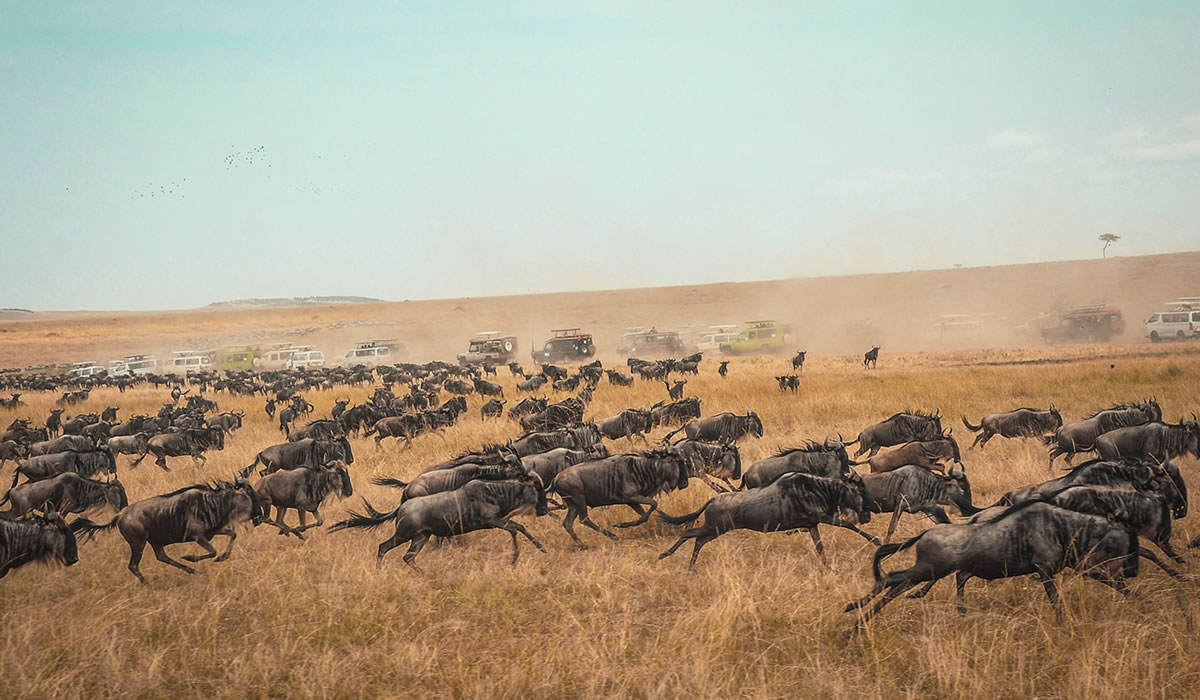
This period, known as the calving season, is also the most intense for predator action. Lions, cheetahs, hyenas and leopards lurk in the grasslands, making it a dramatic time for wildlife photography and observation.
April – May: Migration Northward Begins
As the rains move north, the herds begin trekking through the central Serengeti toward the western corridor. The movement during this period is slower, and the landscape is lush and green. This is the green season, often considered off-peak for tourism due to occasional rain, but it offers quieter safaris and lower prices.
June – July: Grumeti River Crossings and Central Serengeti
By June, the wildebeest gather around the Grumeti River in the western Serengeti. Although not as dramatic as the Mara River crossings, the Grumeti River still presents significant challenges, including strong currents and crocodile-infested waters.
In July, the migration heads toward the northern Serengeti, approaching the famous Mara River. This marks the start of one of the most breathtaking parts of the migration.
August – October: Mara River Crossings and Northern Serengeti to Maasai Mara
The Mara River crossing is the pinnacle of the Great Wildebeest Migration. As the herds cross from Tanzania’s Serengeti into Kenya’s Maasai Mara, thousands of wildebeest plunge into the river in an attempt to reach the other side. The crossings are perilous, with many animals falling prey to crocodiles or drowning in the chaos.
This period offers the best chance to witness this iconic scene and is the peak season for migration safaris in both northern Serengeti and the Maasai Mara.
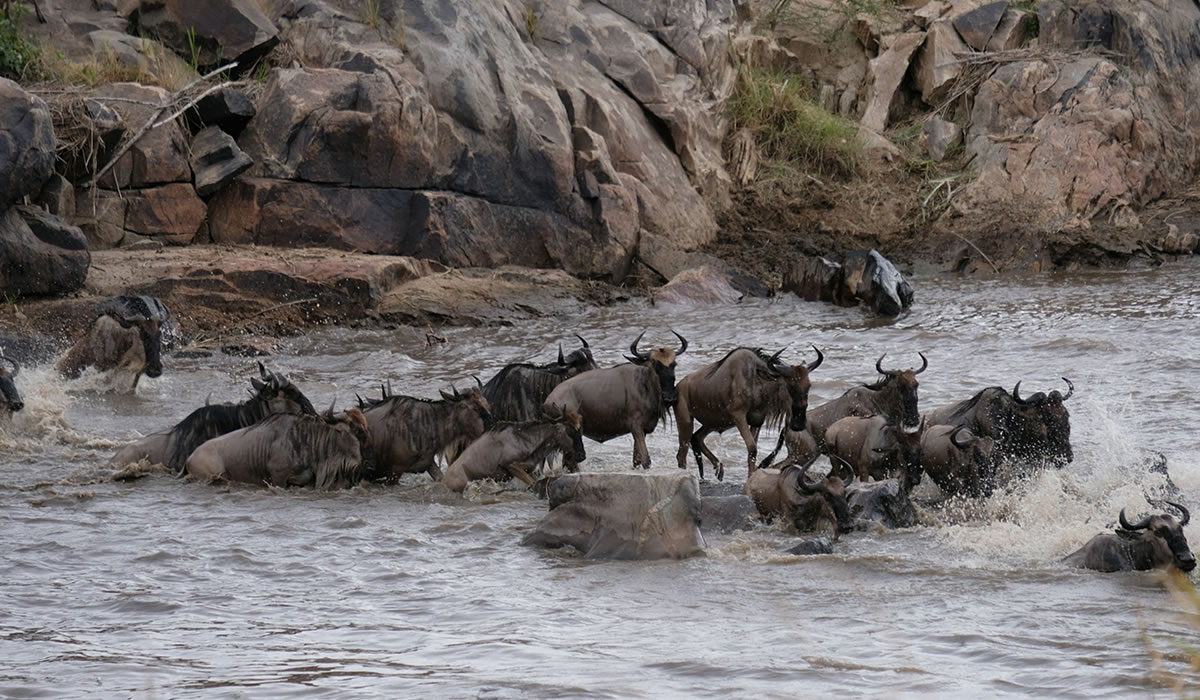
November – December: Return to the Southern Serengeti
With the arrival of the short rains in Tanzania, the herds begin their journey back south through the eastern Serengeti. By December, they reach the southern plains again, completing the annual cycle. This begins another round of the great migration and sets the stage for the next calving season.
Best Places to See the Wildebeest Migration
Serengeti National Park (Tanzania)
The Serengeti is where the majority of the migration takes place. It offers several key viewing zones throughout the year:
- Ndutu Plains: Best from January to March for calving and predator action
- Western Corridor: Best in May to June for Grumeti River crossings
- Northern Serengeti: Best in July to October for Mara River crossings
Serengeti National Park is accessible via Kilimanjaro International Airport or Arusha, with chartered flights and road transfers available to various lodges and camps.
Maasai Mara National Reserve (Kenya)
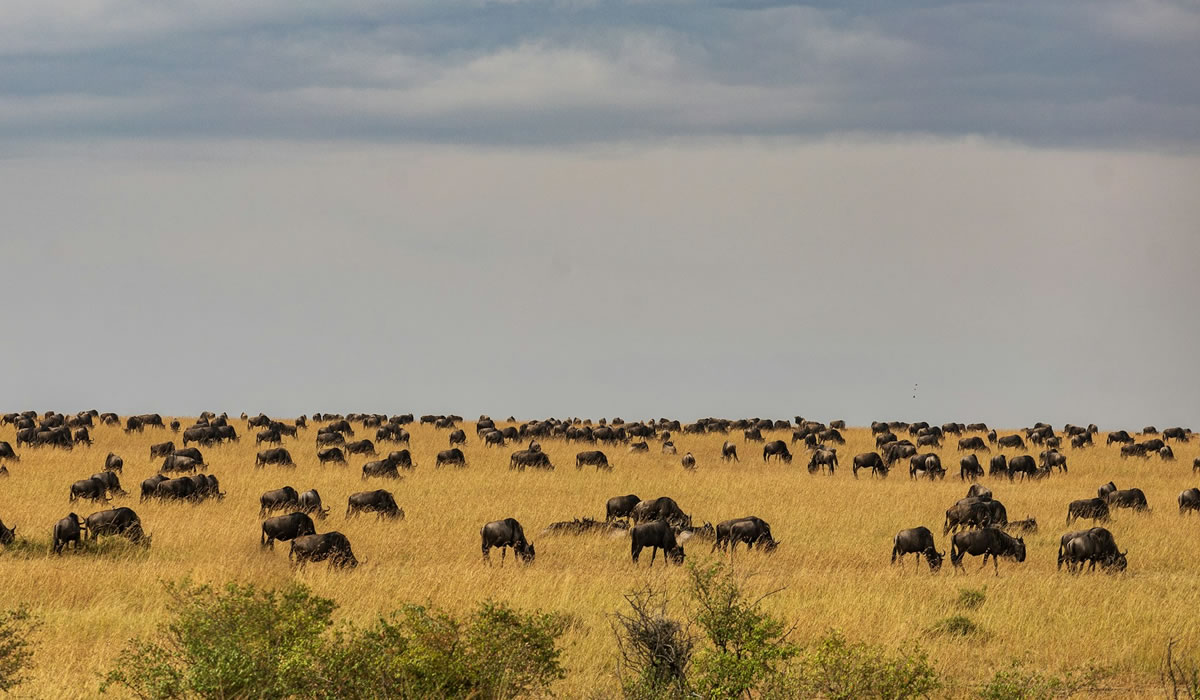
From July to October, the Maasai Mara becomes a hotspot for migration safaris. The Mara River crossings are the highlight, and the open plains provide ideal viewing conditions for both wildlife and scenic landscapes.
Numerous luxury and mid-range camps line the riverbanks, giving visitors front-row access to the action.
Top Safari Camps and Lodges
To fully experience the Great Wildebeest Migration, staying in mobile camps or migration-focused lodges is recommended. These properties move locations based on the herds’ movement or are strategically placed near river crossings. Popular Safari Accommodations include; Sayari Camp, Serengeti Under Canvas, Lemala Ndutu Camp, Kichwa Tembo Camp, Governors’ Camp.
Best Time to See the Great Migration
The best time to see the wildebeest migration depends on what part of the journey you want to witness:
- January – March: Calving season (Ndutu area, southern Serengeti).
- June – July: Grumeti River crossings (western Serengeti).
- August – October: Mara River crossings (northern Serengeti and Maasai Mara).
- November – December: Herd movement southward (eastern and southern Serengeti).
Each phase has its own unique experience, and no matter when you visit, you’re likely to witness some aspect of the migration in motion.
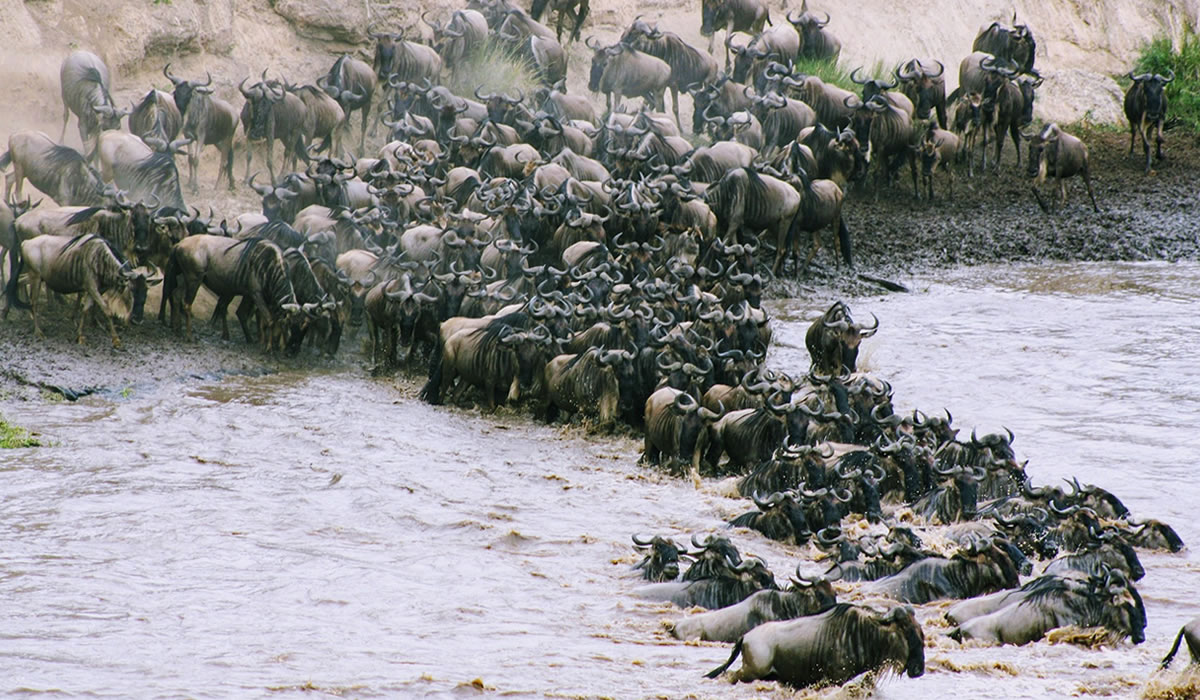
What to Expect on a Migration Safari
Witnessing the Great Wildebeest Migration is a once-in-a-lifetime experience. Safari-goers can expect early morning and late afternoon game drives led by expert guides. Open 4×4 vehicles provide excellent visibility for photography and wildlife observation.
What to pack:
- Neutral-colored clothing for blending into the environment.
- Binoculars and a high-quality camera with zoom lens.
- Sunscreen, insect repellent and a wide-brim hat.
- Layers for cold mornings and warm afternoons.
Wildlife You’ll See
While wildebeest are the stars of the show, a migration safari includes sightings of:
- Zebras and gazelles moving alongside the wildebeest.
- Lions and cheetahs stalking prey during calving and river crossings.
- Leopards in the trees along the riverbanks.
- Hyenas scavenging or hunting in packs.
- Crocodiles lying in wait at river crossings.
- Elephants, giraffes, buffalos and rhinos in surrounding ecosystems.
Bird watchers will also enjoy a diverse range of species, especially during the green season.
Conservation and the Future of the Migration
The Great Wildebeest Migration is not only a natural wonder but also a symbol of the importance of conservation in East Africa. The migration supports local economies, provides thousands of jobs in tourism and helps fund wildlife protection efforts.
However, threats such as climate change, habitat loss, poaching, and human-wildlife conflict pose risks to the migration’s sustainability. Organizations like the Frankfurt Zoological Society, Tanzania National Parks (TANAPA) and Kenya Wildlife Service (KWS) are actively involved in conservation and education initiatives.
Travellers are encouraged to choose eco-friendly safari operators, support local conservation projects and practice responsible tourism.
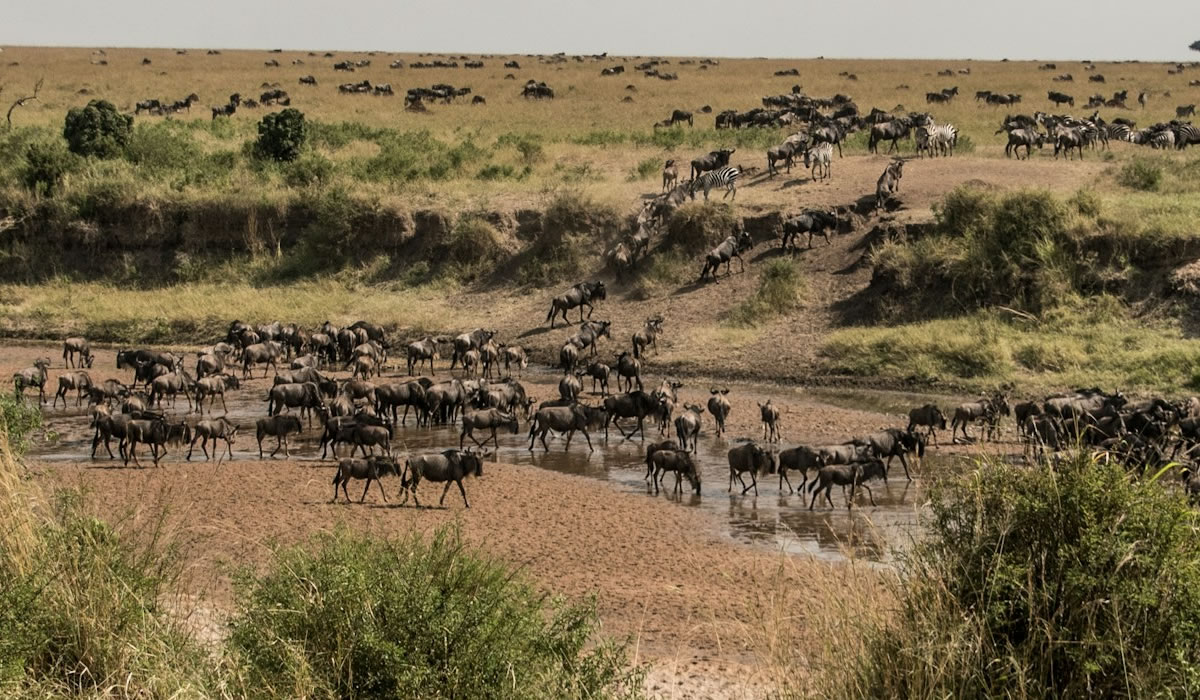
Travel Tips for Witnessing the Wildebeest Migration
- Book early: Migration season is in high demand, especially for river crossing periods.
- Use a reputable tour operator: Experience matters when timing safaris around animal movements.
- Combine destinations: Pair your migration safari with other attractions like the Ngorongoro Crater, Mount Kilimanjaro or Zanzibar beaches.
- Consider travel insurance: Especially for international flights, cancellations and medical emergencies.
The Great Wildebeest Migration is an awe-inspiring testament to the rhythm of nature and the raw power of survival. It is more than just a safari, it is a deeply moving experience that captures the drama, beauty and interconnectedness of life on Earth. Whether you’re witnessing thousands of wildebeest cross a crocodile-infested river or watching newborn calves take their first steps on the plains, the migration offers unforgettable moments for every traveller.
With the right planning, responsible travel choices and a spirit of adventure, a wildebeest migration safari in Tanzania and Kenya will be one of the most memorable journeys of your life.

